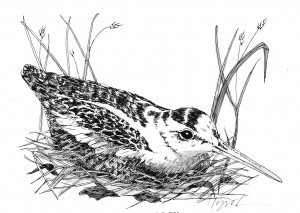Migratory flights of Canada geese are hard to miss. A chorus of honking can be heard in the distance before they come into view in their ever-shifting chevron formation, and witnessing their high-altitude passing is one of our elemental autumn experiences. While the honkers are calling attention to themselves during the day, other migrating birds are on the ground, resting and refueling for their nighttime flights.
One of these less ostentatious migrators is the woodcock, which nests throughout New England and maritime Canada in the spring and then flies south in the fall. The northernmost birds get the earliest start, and they begin reaching Vermont in early October. The arrival of these flight birds temporarily and intermittently augments the local population of birds who have been in Vermont since spring. Soon, the resident birds will also begin their migration, and by mid-November there are only stragglers left.
Woodcock make their way south in increments of fifty miles or so, flying at night and spending a day or two at each stop. Along the way, a journey of as much as 15CX) miles, they look for habitat that will provide cover as well as their daily fill of earthworms. You can find them in bottomlands that are thick with alder and on upland hillsides in second growth forests of young poplar.
Finding them, however, is not as easy as that sounds, for unless you are in the company of a bird dog, it's quite possible that you could spend October in prime woodcock habitat and never lay eyes on one. There are plenty of hikers, birders, and dogless hunters who have never flushed this amazing little gamebird. And unless he flushes, you will not see him. The woodcock maintains his anonymity through a mottled coloration that matches almost anything on the ground with the exception of green grass. The effect of its camouflage is enhanced by its nerves of steel. It will sit tight under all but the most perilous circumstances and unless your hiking boot is about to land on the woodcock, he might never move.
That same quality makes him a wonderful gamebird for the hunter with a bird dog, because a dog that bumps the much spookier ruffed grouse (partridge) all day long can transform himself into a staunch, stylish pointer on a tight-sitting woodcock.
It is about the size of a dove, but while a dove has a certain amount of grace, especially in flight, the woodcock looks like a linebacker. It's a chunky bird with no neck to speak of, and eyes set way back on its head. Add to it a prehensile bill that is half again as long as its head and you have a bird whose proportions seem all wrong.
When flushed from cover, it is not a particularly fast flier — nowhere near as quick as a dove or a partridge — but its route is unpredictable. It is also quite beautiful then—its breast shows off a shade of cinnamon, and its flight posture when silhouetted against a gray sky somehow makes marvelous sense out of the bird's shape.
Unfortunately, woodcock numbers have been declining in the last twenty years, due less to hunting pressure than to loss of habitat both in their northern range where mature forest is becoming dominant but even more so in their southern winter range. Agricultural development in the Gulf Coast and south Atlantic states is steadily eating up woodcock habitat.
While bag limits for hunters have recently been low (three birds a day) and the season short (about six weeks), many hunters are voluntarily limiting their take to no more than a couple of woodcock in a season. It's a good idea. Let them fly.


